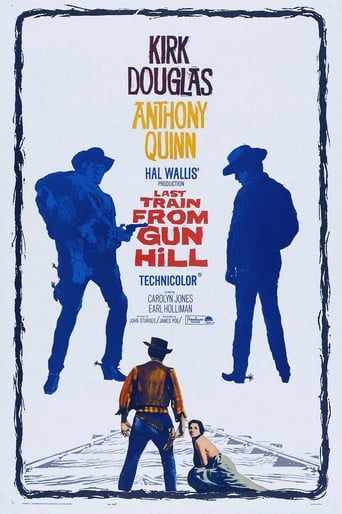kcterrell-25046
A Sturgis masterpiece. The story and the soundtrack are somewhat contrived, But outstanding performances by Douglas, Quinn, and Jones. The sets, the costuming, and the makeup in this film are all perfect. The accessories are all true to the time, and kudos to the gaffers, leaving no stone unturned to making this nice movie completely believable. The only scene to the contrary is the bar room scene when Douglas fires six shots and yet forces all of the men at gunpoint into the next room. Jones' performance is greatly unappreciated as the femme fatale to both protagonists. At times, the makeup accentuates her wide white eyes, and in the final scene, the eyeliner lets her blue eyes be captured on the wide screen like the movies of an earlier era. I only wish I could see this movie on a big screen, because that is how Sturgis directed the movie to be seen. It is refreshing to see so much attention to detail in a Western movie, that should be admired and seen more than once to fully appreciate the small things.
dougdoepke
Despite the big names—Quinn, Douglas, director Sturgis—the western's nothing special. The story starts off powerfully with the assault and murder of Matt's wife; at the same time, the suspense is built into the soured friendship between Craig and Matt since it's Craig's son Rick (Holliman) who's perpetrated the assault. Now Matt wants to bring him to justice despite dad's opposition. On the other hand, Carolyn Jones' shady lady fits in somewhere. Trouble is that like too many A-oaters of the time, this one suffers from bloat as producers load up with stars and extended runtime, likely to compete with TV. Then too, the plot's clearly derivative from the preceding year's 3:10 To Yuma, as other reviewers point out. And that's even down to the extended hotel scene, which unfortunately sags the middle part. All in all, it looks like the production may have been a hurry-up since the action is mainly confined to Paramount's backlot.That's not to say the movie is devoid of positives. Douglas brings his usual intensity, while Quinn makes a persuasive adversary. But I especially like the underrated Earl Holliman who was so good at callow youth. Then too, it's the most glamorous I've seen Carolyn Jones who usually got supporting roles. Anyhow, the suspense is dragged out not too effectively right down to the clichéd showdown. Frankly, it's oaters like this that make me appreciate the small-budget Ranown series of tight, taut, Randolph Scott westerns, e.g. The Tall T (1957). Perhaps that's why-- unlike the Ranowns-- this A-List effort has since drifted into obscurity, despite the big names.
arangoc
In an era when movie plots were quite similar I just can't refrain from saying that this movie is an excellent copycat of Columbia Pictures' 3:10 to Yuma played by Glenn Ford and Van Heflin two 2 year earlier. The movies are not exactly the same but the hotel scenes and having to wait for the train would be enough for today's Apple's lawyers if working for Columbia to sue Paramount. But never mind, both movies are excellent; perhaps the stronger characters of Kirk Douglass and Anthony Quinn beat soft Glenn Ford. To make it even watch 3:10 to Yuma's 2007 excellent remake by Christian "Batman" Bale & Russell Crowe. I still can't figure out how Police Woman's Earl Holliman who plays Quinn's son made it to Hollywood but again, in the fifties grocery clerks with absolutely no acting skills became actors (ring a bell?... the guy with the famous poncho!).
wgregh
This comment is not offered for titillation's sake but questioning the film's showing Kirk Douglas' Native American wife in the opening minutes when she was raped and murdered. Earl Holliman's character stripped off her blouse, though not before the camera lens but with a whip. Then there's a cut to a shot of her struggling to be modest. Next we heard shouts of horror from her character without viewing her. It was pretty clear what occurred. I was amazed for a '59 film that it showed her upper torso almost naked with outlines of her lower breasts. I'm gay, so it wasn't a big turn-on for me, but didn't it seem a bit amazing for a time when standards and practices were semi-prudes well before more open sexuality came into Hollywood about five years later? Or did I get it wrong or do I not know how Hollywood captured sexual/horror scenes in the late '50s?




